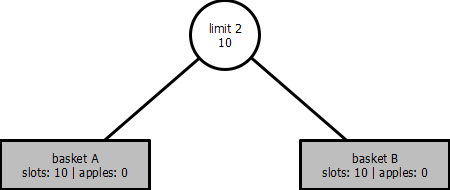Blog Posts
Cloudwatch Alarm On Disk Space
Mar 15th, 2019Few weeks ago we saw how to configure CloudWatch to monitor upstream response time from logs. We create a CloudWatch configuration which allowed us to create metrics by parsing the logs and create a dashboard out of it. Building up from there, today we will see how we can monitor disk used space and trigger an alarm when the remaining disk space is critical.
Cycle Detection With Floyd Tortoise And Hare
Mar 6th, 2019Floyd’s Tortoise and Hare is a cycle detection algorithm operating on a linked list. The algorithm is based on two pointers, the tortoise and the hare, moving on the linked list at a different speed. The algorithm can be used to find cycle existence, deduces the beginning of the cycle, and the length of a cycle. Today we will explore the mathematical proof behind the algorithm and we will implement it in Racket.
The Basket Of Apples Problem With Tree
Mar 1st, 2019Fixed Point And Newton Method
Feb 22nd, 2019Recursion With Fibonacci
Feb 14th, 2019Recursion refers to the property of a function to be defined in term of itself. The Fibonacci sequence is a great example of a recursive problem where a Fibonacci number is calculated from a combination of precedent Fibonacci numbers. Recursion can be implemented in many forms, it is even possible to implement recursion without explicit self calling. Today we will look at different implementations of Fibonacci and discover their properties.
Lambda Calculus And Closure
Feb 6th, 2019In programming, we often hear about Closures. Closures are present in any languages possessing functions as first class citizen. This includes functional languages and also widespread languages such as C#, Python and JavaScript. Today we will look at the origin of closures and understand what they are.
Implementing Exceptions With Continuations Racket Lisp
Jan 30th, 2019Last week a colleague of mine introduced me to the concept of continuation in Racket (the best of Scheme and Lisp - at least that is what racket-lang.org states). I knew about the existence of Lisp but I never really paid attention to what it provided as language features. So I took the bite and started to read the post shared to me on continuations, written by Matt Might and oh boy… was I confused. Everything about the code confused me, the notation, the syntax, and of course the flow of the program itself. What I understood was that this piece was implementing Exceptions by using continuations which was enough to make me want to understand it.
Property Based Testing With Hypothesis
Jan 25th, 2019Python Web Api With Flask
Jan 18th, 2019Flask is a microframework for python providing building blocks to compose websites and web API quickly. It has a vast ecosystem driven by open source libraries maintained and used by many developers. Today we will see how we can setup a simple todo web API using Flask and how we can setup OpenAPI 3.0 (OAS3 - previously known as Swagger).
Prometheus With Aspnetcore
Jan 11th, 2019Prometheus is an open source monitering platform. It provides multiple functionalities to store, manipulate and monitor metrics from our applications. Today we will see how we can push metrics from an ASP NET Core application, and how to make sense of it.
Custom Blue Green Deployment With Nginx And Gitlab Ci
Jan 4th, 2019Create A Blog With Jekyll
Dec 28th, 2018Jekyll is a blog aware static site generator. Blog aware means that it ships with functionalities to build blogs and blog posts. The two major benefits from Jekyll are the markdown translation to HTML and its blog creation orientation. I recently migrated out of blogger and moved to building my own website using Jekyll and today I will share the steps I took.
Vegeta Load Test
Dec 21st, 2018Load testing helps catch problems which only appear in high load. A common use case of load testing is to load our API with an amount of request of two or three times higher than the usual load. This will provide confidence in our API ability to handle larger traffic. Today we will look into Vegeta, an open source HTTP load testing tool quick and easy to setup. In this post, I’ll demonstrate how quickly and easily we can load test our API endpoints.
Create React App And Mobx
Dec 14th, 2018Https With Letsencrypt And Certbot
Dec 7th, 2018 chrome
chrome
 cypress
cypress
 dbeaver
dbeaver
 ethereum
ethereum
 figma
figma
 flask
flask
 git
git
 graphql
graphql
 jekyll
jekyll
 jenkins
jenkins
 js
js
 maths
maths
 metamask
metamask
 mobx
mobx
 mysql
mysql
 oas
oas
 postgres
postgres
 postman
postman
 puml
puml
 python
python
 solidity
solidity
 splunk
splunk
 sqlalchemy
sqlalchemy
 sqlite
sqlite
 typescript
typescript
 unicode
unicode
 vscode
vscode
 zsh
zsh

